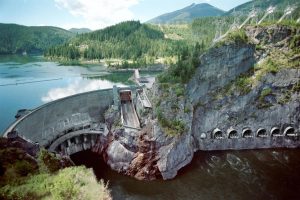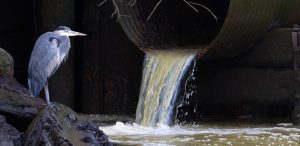13 So… What Does Ecology Have to do With Seattle?
Mikaela Williams
Climate Change on Hydropower
Seattle City Light provides power for about 1 million people in Seattle and the communities surrounding the city. They do this by being 90 percent reliant on hydroelectric power. Long-term climate change threatens this source of power with rising temperatures, the rising sea level, and more extreme projected precipitation levels (Greenest). The impacts of climate change include a drier summer and wetter spring, winter, and fall seasons. By the 2050s, we can expect to see, on average, a -22 percent decline in rainfall during the summer months in Seattle(Mauger). This poses a significant problem for a city heavily reliant on hydroelectricity.

In actuality, the other, projected wetter, seasons have additional adverse effects on hydropower. Seattle City Light depends on the area’s snowpacks to store water: these will be used maintain power throughout the drier summers. However, the combination of warmer temperatures, rising sea levels, and more rain will cause glaciers and snowpacks to melt faster(Greenest). This leaves the summer months without reserve power when the rainfall is already light during that time of the year. Without reliable and sustainable rainfall, hydroelectric dams rely on that naturally stored water to provide power to one of the most established tech hubs in the country. Now, even the backup plan is literally melting away, creating a future with severe power shortages during the summer. Without the power generated by hydroelectric dams, Seattle will need to invest and explore other means of electricity. These expenditures will be costly and may not have the advantages of clean, renewable power. If we return to using fossil fuels, the emissions emitted when burned will make the effects of climate change worse, putting Seattle right back to where it started—without hydropower and clean energy.
For more information about energy systems in Seattle, visit: Dollars and Sense: The Rationale Behind Subsides for the Energy Industry
How Seattle’s Famous Rain Carries Pollution into Our Waters

Polluted rain runoff is one of the biggest toxic threats facing the Puget Sound(Pollution).The Puget Sound acts like a bathtub: being separated from the ocean as a small inlet, it has different characteristics than an ocean does. Pollutants from shipping vessels, recreational boats, and dumping grounds do not just wash out to sea. Instead, the Puget Sound collects all of the oil, plastic, and pollution that the surrounding communities produce. Rain washes pollutants off the streets and into the Puget Sound—pollutants like chemicals, oil, autofluids, fertilizers, and litter. Most stormwater systems in Seattle do not involve treatment of the runoff water, which “can be so toxic that it kills fish in less than three hours” (Pollution).
With all of the pollution trapped in the Puget Sound, fish aren’t the only organisms that are dying. Due to ocean acidification, pollution, habitat destruction, phytoplankton are dying as well. With plankton resting at the very bottom of the food chain, a decrease in phytoplankton can have disastrous effects on the entire ecosystem. Without an abundance of phytoplankton, its natural predators (zooplankton, jellyfish, and krill) starve and are unable to nourish the next level of the food pyramid, which in turn can’t sustain the next, and so on(Spencer). Without phytoplankton, the Puget Sound’s and ocean’s animals will starve, eventually leading to the extinction of marine wildlife indigenous to this area.
Dying Plankton, Dying Fish
In addition to being the most basic unit of marine life, phytoplankton processes carbon dioxide in the water through photosynthesis, extracting the carbon as bodybuilding material while releasing oxygen back into the ocean. In fact, the ocean provides the world with 50 percent of our oxygen; the vast majority of that oxygen being produced by phytoplankton(sscssite2017). When a large amount of phytoplankton is disrupted, a huge supply of the water’s oxygen is taken away. Without the phytoplankton converting carbon dioxide into usable oxygen for the marine wildlife, marine animals suffocate and die.
Areas that are low in oxygen are known as “dead-zones,” and they are everywhere in the Puget Sound. In 2015, a record-breaking low in oxygen levels in the Puget Sound occurred in Hood Canal. Hood Canal has been known to have low oxygen levels in the late summer, but this year hundreds of rockfish, crabs, and even eels came out of their dens or up to the surface, trying to get more oxygen(Ahearn).
Since this is happening in the Sound itself, soon a lack of oxygen will spread to the entire Puget Sound region. Lifelong symptoms of hypoxia in humans are manifested through hypoxemia; when oxygen saturation levels in the body’s hemoglobin cells drop. This leads to an under-oxygenated individual. Lifelong hypoxia can lead to seizures, heart failure, chronic lung disease, higher infant mortality, lower lifespan, and the acceleration of any chronic respiratory disease(Livina). (Other health impacts of climate change can be found here: Environmental Health Disparities in Seattle.) With the increase of pollutants in the Puget Sound, the phytoplankton indigenous to this area will die off, resulting in marine animal deaths through starvation and suffocation. This suffocation can reach humans as well, so it is imperative that we take care of our Puget Sound.
https://www.youtube.com/watch?v=dzjkoC6up-s&feature=emb_logo
Conclusion
The Puget Sound area relies on its namesake. Climate change’s effects on the water cycle and the marine life have serious consequences for Seattle and its surrounding communities. In order to protect Seattle from power shortages, the loss and destruction of indigenous wildlife, and human health risks, serious action needs to be taken to reform environmental policies. Seattle relies on the Puget Sound as a place of commerce and recreation, and now, we need to change our way of living in order to protect what cannot be replaced.
For more information about actions concerning environmental justice, visit Organizing Efforts.

